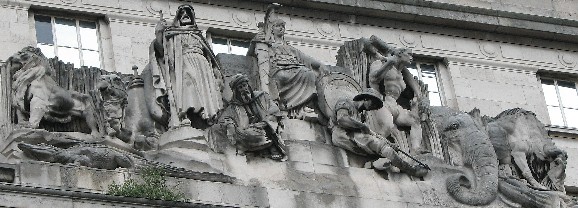
Sculpture by Benjamin Clemens on Africa House, Kingsway, 1922.
Sculpture by Benjamin
Clemens on Africa House, Kingsway, 1922.
Kingsway, a new road of the 1900s, is rather horrible at the southern end, coming in from Aldwych, but becomes progressively better as we go north towards the underground station end. Architectural sculptural interest is from the early 20th century, and includes half a dozen groups, including attributable work by Richard Garbe, LF Roslyn and Gilbert Seale, and Benjamin Clemens, above.
Starting from Aldwych, our first view is backwards, towards the grand portico of Bush House, built in the 1930s, by the American architects Corbett and Helmle. Up above tree level, it bears suprematist-style statues of England and America by the American sculptor Malvina Hoffman.
We proceed northwards a few minutes, past some ugly modern blocks. Our first sculptural work on Kingsway itself, on the left hand side, on the corner of Kemble Street, is Leeds Building Society, no. 40 or 41. The sculptural decoration consists of a good pair of a swirly-tailed mermaid and merman above the corner entrance, with little Roman-style dolphins between. The group is signed by Gilbert Seale and Son, sculptors, and Gibson, Sopwith and Gordon architects. There is a cupola high up over the corner, and round the corner, a couple of winged cherubic heads of a type favoured by Gilbert Seale.
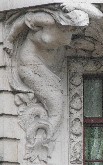 Mermaid, by Gilbert Seale, Leeds Building Soc.
Mermaid, by Gilbert Seale, Leeds Building Soc.
Next, on the right hand side of Kingsway is Remnant Street, and on the right hand corner of this is Imperial Buildings (1913, Trehearne and Norman). Above its two entrances are two pairs of figures, signed by LF Roslyn, 1914, a male and female to each pair, flanking a shield with IB of Imperial Buildings and some small motif. One pair apparently symbolises work and commerce (man with hammer, girl cradling an ocean liner). The other pair signifies the Empire (Roman soldier with full armour, shield and sword) and perhaps learning semidraped girl with a feather for writing). All in stone, good work, especially the Roman. Round the corner, a lionís head higher up.
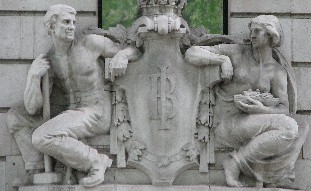 L.F. Roslyn's sculpture for Imperial House, Kingsway.
L.F. Roslyn's sculpture for Imperial House, Kingsway.
On the opposite side again is Parker Street. The building on its right hand corner has a pair of crouched girls, with swirling cloaks, above the corner entrance. The building on the left hand corner and occupying the whole block through to Great Queen Street, is Kingsway House (1906, by Sykes), with a series of projecting balconies held up by alternating pairs of mermaids and mermen, more properly grotesques, in that their tails are more decorative flourishes than fishlike in nature. Engaging. (See here for a page on mermaid sculpture.)
A bit further, again on the right but needing to be seen from the other side of the road, is Africa House. It is essentially a massive oblong block, with the central third treated as a portico. The actual arched entrance is only of ground floor height, with 6 storeys above it, but above to left and right are stone lions, then above, pillars running from 2nd to 5th floor height - Corinthian of course - then a blocky and massive pedimental sculptural group, then two further storeys and some small crest in the shape of a shell. The two lions, couchant, are very severe, and firmly date the building in the early 1920s. The tops of the pillars bear African faces of various types. The sculptural group, a low pyramidal composition, is too high up to be seen from a good angle even on such a wide road. It contains three main figures, two subsidiary ones, and various animals. The central figure, a seated female, with oversize Corinthian crest and sword, and a round shield from which the design has been worn away. Possibly a Britannia, rather ugly. On the left hand side, two Arabic men, seated and standing, a lion, seated camel and stretched out crocodile, with reeds behind - see picture at top of page. To the right hand side, a black man carrying tusks, a seated colonial loading a gun, the head of an elephant, probably dead, a standing wildebeest and a snake, all among tall grasses. Suitably exotic. The sculptor was a certain Benjamin Clemens, a now rather obscure sculptor who exhibited from shortly after the turn of the century, mostly female nudes, before turning to teaching.
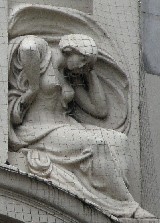 One of two girls, block next to Parker Street.
One of two girls, block next to Parker Street.
After this grand building, we arrive at Holborn Station. I should mention that behind the buildings on the right hand side, lies Lincoln Inn Fields, with the wonderful Soane Museum, but this is not covered here. The classical portico almost opposite the station, now housing a Government agency, once the lower part of Holy Trinity Kingsway, by the architect John Belcher and his partner J. J. Joass, bears a pair of slight semidraped stone figures, which I have not identified.
Standing by the station at the corner, look up at the red-brick Queen Anne style building a couple of frontages along on High Holborn. It is called Kingsgate House, no 114-115, and high up at 5th floor level are seated statues of two kings - Edward I and Edward VII, by Richard Garbe. You will need a pair of binoculars to appreciate them properly, so here they are.
Finally, before entering the station, or wandering westwards towards the British Museum, carry on north into Southampton Row, because by the first street off it, called Catton Street, is a statue of John Bunyan on the face of a building, most likely in terra cotta. A pleasantly-faced work by the always interesting Richard Garbe, dating from 1903. Bunyan is there because this building was built as the headquarters of the Baptist Union, and to its rear is the octagonal Kingsgate Baptist Church. The Board Room of the Baptist Union had, and perhaps still has, two sculptured panels by George Tinworth.
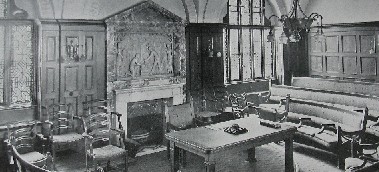 Board Room, Kingsway Baptist Union building, with panel by Tinworth.
Board Room, Kingsway Baptist Union building, with panel by Tinworth.
North-West to Bloomsbury Square // or West to Oxford Street // East to the Prudential War Memorial
Southern end, walk along Aldwych // Walk along the Embankment // Northern end, east to Holborn Viaduct
Visits to this page from 23 Nov 2011: 9,861